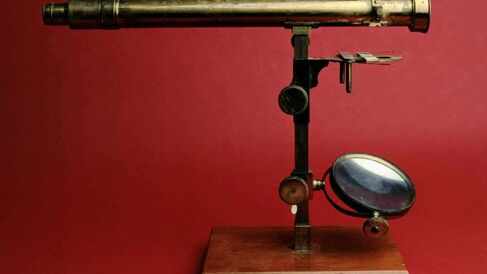Amici Microscopes and Thomas Romney Robinson

The Whipple Museum has five items made by the Italian professor Giovanni Battista Amici. Working in the early- to mid-19th century, Amici's microscopes were owned by some leading members of the scientific community. One of the Whipple's examples was supposedly Amici's own working microscope; another belonged to an Irish astronomer, Thomas Romney Robinson.
Join us for a day exploring the Arctic and the animals and people that live there! Crafts and activities for all ages throughout the day as well as a chance to see live reindeer and find out about the people that live and work with them. We will join other special guests from the Museum of Zoology and the Museum of Archaeology and Anthropology to run exciting activities.
Part of the Festival of Ideas
Location: The Polar Musrum
All ages, drop in, free.
Giovanni Battista Amici
The Italian mathematics teacher, microscopist, and astronomer Giovanni Battista Amici (1786-1863) began designing and making microscopes in 1809. Alongside his professorial duties, Amici was a pioneer of the reflecting microscope, which creates an enlarged image via mirrors, rather than just using (refracting) lenses. Like many developments in microscope manufacture, reflecting microscopes were modelled on their telescopic counterparts. Whereas reflecting and refracting telescopes have competed and coexisted right up to the present day, Amici's reflecting microscopes were only popular for a short time around the 1820s. This is because of the small sizes of the mirrors needed for a high-power microscope, and the incredible amount of skill required for their construction and polishing. The earliest surviving example of one of these distinctive microscopes is dated 1814, and is now in a museum in Amici's birthplace, Modena, Italy.(1)
Of three reflecting microscopes in the Whipple Museum's collections one is by Amici. And it is supposedly his own working microscope (above image). It was purchased in 1930 at the auction of the collection of Frank Crisp, a microscope collector, who in turn had bought it from an Italian professor, who "had it direct from Amici's heirs". The sale catalogue describes the microscope as being Amici's own working instrument, but given its complicated history this claim is impossible to verify.
Problems of ownership
This kind of uncertainty about previous ownership is not uncommon in museum records. Sometimes there is enough evidence to ascertain exactly who owned an instrument. This is the case for another microscope connected with Amici.
It is an early achromatic microscope, made in about 1835. In its box there is a hand-written note that begins "The gift of the celebrated Amici to me". The note was written by Thomas Romney Robinson (1793-1882), an Irish astronomer. Robinson had attained fame as a poet before he turned ten, and after attending Trinity College Dublin he established himself in the 19th-century scientific community.
He was based at the small observatory in Armagh. His various projects and researches led to his most famous invention, the cup-anemometer (Image 2), which measures wind speed.
Unlike many contemporary scientists he was "interested in instrument design and mechanical operation, and prided himself on his own skill with file and lathe".(2)
Other objects at the Whipple demonstrate Robinson's curiosity: a block of glass that has been exposed to an electrical discharge is labelled "Piece of Glass perforated by a spark by Ruhmkorff given to me by Mr Gassiot / Dec. 20. 1861 / T.R. Robinson" (Image 3); and a small refracting telescope is labelled "Sir James South lent this to me Jan 1862 and he gave it to me in the summer of 1862. It is by Cuthbert a famous maker of Dumpy telescopes and defines sharply / T.R.Robinson".
Given this practical knowledge of instruments, the lenses and microscopes made by Amici would have interested him greatly, and Robinson's note in the microscope box continues:
"The lower object glass is such as the microscopes made by him are commonly furnished with. The higher is such as he had made for his researches ... and I am the first to whom he ever gave one of them."
References
- Held at Museo Universitario di Storia Naturale e della Strumentazione Scientifica: University of Modena.
- J. A. Bennett, 'Robinson, (John) Thomas Romney (1793-1882)', Oxford Dictionary of National Biography (Oxford: Oxford University Press, 2004), available online at: Oxford DNB (available to subscribers only).
Further reading
- G. L'E. Turner, The Great Age of the Microscope: The Collection of the Royal Microscopical Society through 150 Years (Bristol and New York: Adam Hilger, 1989), p. 243.
- J. A. Bennett, Church, State, and Astronomy in Ireland: 200 Years of Armagh Observatory (Belfast: Institute of Irish Studies, 1990), pp. 59-152.
Boris Jardine
Boris Jardine, 'Amici microscopes and Thomas Romney Robinson', Explore Whipple Collections, Whipple Museum of the History of Science, University of Cambridge, 2006
